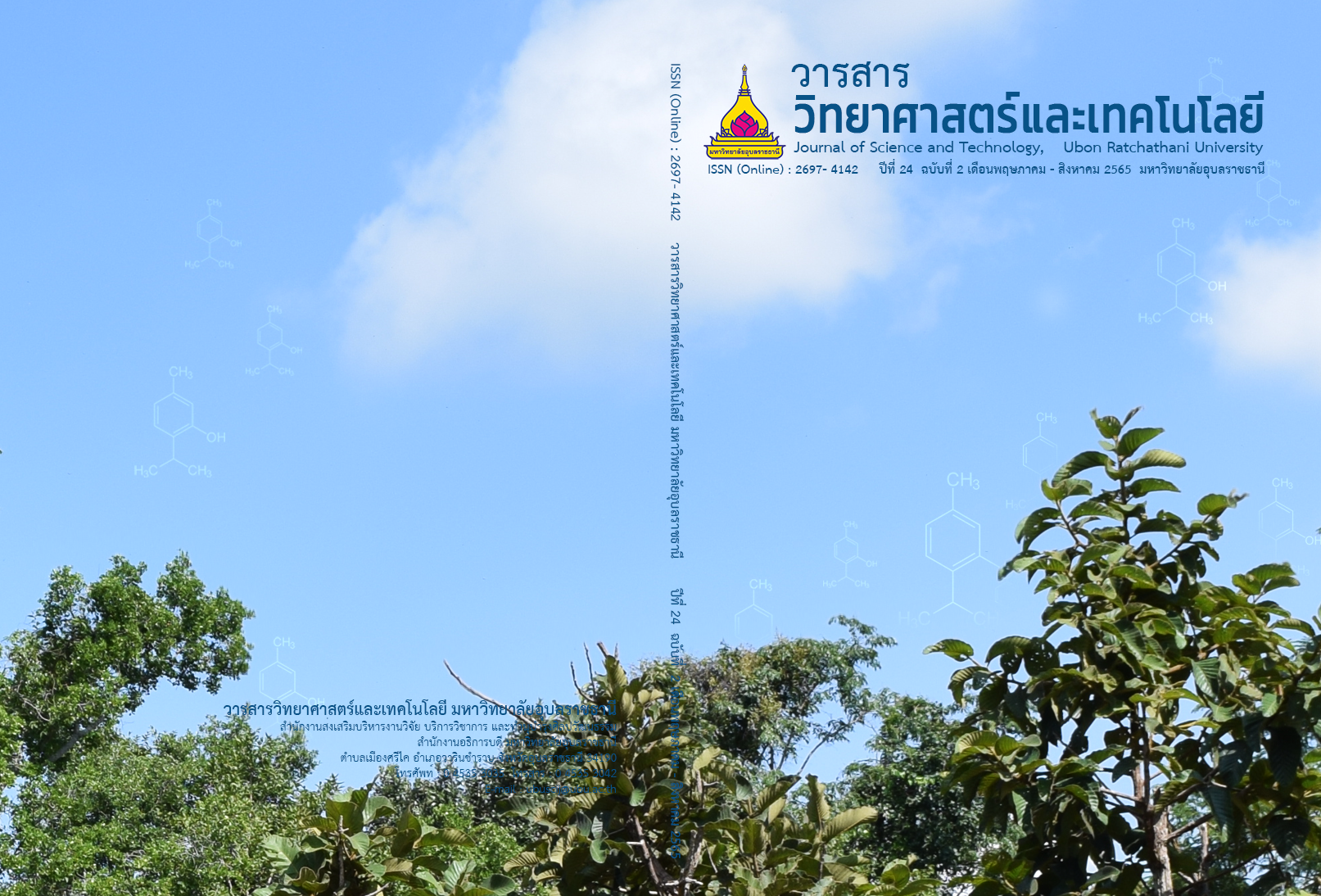ฤทธิ์ต้านอนุมูลอิสระและความเป็นพิษต่อเซลล์มะเร็งมนุษย์ของสารสกัดด้วยน้ำใบเขืองน้อย ใบหัวใจทศกัณฐ์ และใบหางไหล
Main Article Content
บทคัดย่อ
การศึกษานี้มีวัตถุประสงค์เพื่อประเมินฤทธิ์ต้านอนุมูลอิสระและความเป็นพิษต่อเซลล์มะเร็งมนุษย์ ซึ่งได้แก่ เซลล์มะเร็งตับ (HepG2) มะเร็งเม็ดเลือดขาว (Jurkat) และมะเร็งเต้านม (MCF-7) ของสารสกัดด้วยน้ำของใบเขืองน้อย ใบหัวใจทศกัณฐ์ และใบหางไหล สารสกัดถูกตรวจสอบปริมาณฟีนอลิกและฟลาโวนอยด์ทั้งหมด และฤทธิ์ต้านอนุมูลอิสระด้วยวิธี FRAP และ DPPH รวมถึง การทดสอบความเป็นพิษต่อเซลล์มะเร็งมนุษย์ด้วยวิธี MTT ผลการศึกษาพบว่าทั้งปริมาณฟีนอลิกและฟลาโวนอยด์ทั้งหมด และฤทธิ์ต้านอนุมูลอิสระ พบสูงสุดในสารสกัดใบหางไหล รองลงมาคือสารสกัดใบเขืองน้อยและสารสกัดใบหัวใจทศกัณฐ์ ตามลำดับ สารสกัดใบหางไหลก่อให้เกิดความเป็นพิษต่อเซลล์มะเร็งมนุษย์ทั้งหมดที่ใช้ในการทดสอบมากกว่าสารสกัดใบเขืองน้อยและใบหัวใจทศกัณฐ์ ตามลำดับ สารสกัดใบหางไหลมีความเป็นพิษสูงสุดต่อเซลล์ Jurkat (IC50 = 0.20 mg/mL) รองลงมาคือ เซลล์ MCF-7 (IC50 = 0.42 mg/mL) และเซลล์ HepG2 (IC50 = 0.76 mg/mL) ตามลำดับ การวิเคราะห์สหสัมพันธ์ของเพียร์สันแสดงให้เห็นว่าปริมาณฟีนอลิกและฟลาโวนอยด์ทั้งหมดมีความสัมพันธ์กับฤทธิ์ต้านอนุมูลอิสระของสารสกัด ผลการศึกษาชี้ให้เห็นว่าสารสกัดใบหางไหลมีปริมาณฟีนอลิกและฟลาโวนอยด์ทั้งหมดสูง ทำให้มีศักยภาพสูงในการต้านอนุมูลอิสระและเป็นพิษต่อเซลล์มะเร็งมนุษย์ที่ใช้ทดสอบทั้งหมด
Article Details

อนุญาตภายใต้เงื่อนไข Creative Commons Attribution-NonCommercial-NoDerivatives 4.0 International License.
บทความที่ได้รับการตีพิมพ์เป็นลิขสิทธิ์ของ วารสารวิทยาศาสตร์และเทคโนโลยี มหาวิทยาลัยอุบลราชธานี
ข้อความที่ปรากฏในบทความแต่ละเรื่องในวารสารวิชาการเล่มนี้เป็นความคิดเห็นส่วนตัวของผู้เขียนแต่ละท่านไม่เกี่ยวข้องกับมหาวิทยาลัยอุบลราชธานี และคณาจารย์ท่านอื่นๆในมหาวิทยาลัยฯ แต่อย่างใด ความรับผิดชอบองค์ประกอบทั้งหมดของบทความแต่ละเรื่องเป็นของผู้เขียนแต่ละท่าน หากมีความผิดพลาดใดๆ ผู้เขียนแต่ละท่านจะรับผิดชอบบทความของตนเองแต่ผู้เดียว
เอกสารอ้างอิง
Sung, H. and et al. 2021. Global cancer statistics 2020: GLOBOCAN estimates of incidence and mortality worldwide for 36 cancers in 185 countries. CA: A Cancer Journal for Clinicians. 71(3): 209-249.
Imsamran, W. and et al. 2014. Cancer. http://training.dms.moph.go.th/rtdc/storage/app/uploads/public/59b/9e7/953/59b9e79536bef196682686.pdf. Accessed 10 January 2022. (in Thai)
Gyamfi, J., Kim, J. and Choi, J. 2022. Cancer as a metabolic disorder. International Journal of Molecular Sciences. 23: 1155.
Bidram, E. and et al. 2019. A concise review on cancer treatment methods and delivery systems. Journal of Drug and Delivery Science and Technology. 54: 101350.
Johnson, S.B. and et al. 2018. Use of alternative medicine for cancer and its impact on survival. Journal of the National Cancer Institute. 110(1): 121-124.
Morarach, A. and Hemathulin, S. 2021. Physical properties, phenolic contents and antioxidant activity of Mao Luang. Journal of Science and Technology, Ubon Ratchathani University. 23(3): 70-79. (in Thai)
Muniyandi, K. and et al. 2019. Phenolics, tannins, flavonoids and anthocyanins contents influenced antioxidant and anticancer activities of Rubus fruits from Western Ghats, India. Food Science and Human Wellness. 8(1): 73-81.
Costa-Lotufo, L.V. and et al. 2005. Studies of the anticancer potential of plants used in Bangladeshi folk medicine. Journal of Ethnopharmacology. 99(1): 21-30.
Kuo, C.Y. and et al. 2019. Ethanolic extracts of dietary herb, Alpinia nantoensis, exhibit anticancer potential in human breast cancer cells. Integrative Cancer Therapies. 18: 1534735419866924.
Emam, M.A., Khattab, H.I. and Hegazy, M.G. 2019. Assessment of anticancer activity of Pulicaria undulate on hepatocellular carcinoma HepG2 cell line. Tumour Biology. 41(10): 1010428319880080.
Doi, K. and et al. 2017. Andrographolide from the herb Andrographis paniculata induces apoptosis on cultured human leukemic cells. Fujita Medical Journal. 3(3): 48-54.
Sittisart, P., Dunkhunthod, B. and Chuea-nongthon, C. 2020. Antioxidant and anti-inflammatory activities of ethanolic extract from Hoya kerrii Craib. Chiang Mai Journal of Science. 47(5): 912-925.
Sittisart, P. and et al. 2019. Anti-proliferative and apoptosis-inducing activities of Derris elliptica (Roxb.) Benth. leaf extract on three human cancer cell lines. Maejo International Journal of Science and Technology. 13(1): 62-71.
Rupasinghe, H.P.V. and et al. 2008. Effect of baking on dietary fibre and phenolics of muffins incorporated with apple skin powder. Food Chemistry. 107(3): 1217-1224.
Settharaksa, S. and et al. 2014. Effect of solvent types on phenolic, flavonoid contents and antioxidant activities of Syzygium gratum (weight) S.N. International Journal of Pharmacy and Pharmaceutical Science. 6(2): 114-116
Yang, H. and et al. 2011. Antioxidant compounds from propolis collected in Anhui, China. Molecules. 16(4): 3444-3455.
Sittisart, P. and et al. 2021. Cytoprotective and hypoglycemic activities of ethanol extract of Hoya kerrii Craib Leaf. Chiang Mai Journal of Science. 48(2): 395-404.
Lyu, J.I. and et al. 2022. Comparative study on phenolic compounds and antioxidant activities of Hop (Humulus lupulus L.) strobile extracts. Plants. 11(1): 135.
Speisky, H. and et al. 2022. Revisiting the oxidation of flavonoids: Loss, conservation or enhancement of their antioxidant properties. Antioxidants. 11(1): 1-28.
Sae-Yun, A. and et al. 2006. Extraction of rotenone from Derris elliptica and Derris malaccensis by pressurized liquid extraction compared with maceration. Journal of Chromatography A. 1125(2): 172-176.
Cunningham, M.L. and et al. 1995. Rotenone, an anticarcinogen, inhibits cellular proliferation but not peroxisome proliferation in mouse liver. Cancer Letters. 95(1-2): 93-97.
Liu, Y.-Q. and et al. 2012. Design, synthesis and cytotoxic activity of novel spin-labeled rotenone derivatives. Bioorganic & Medicinal Chemistry Letters. 22(2): 920-923.
Fang, Y. and et al. 2010. Antifungal and antitumor constituents in Derris elliptica (Roxb.) Benth. waste. Agrochemicals. 12: 874-875.
Tungmunnithum, D. and et al. 2018. Flavonoids and other phenolic compounds from medicinal plants for pharmaceutical and medical aspects: An overview. Medicines. 5(3): 93.


